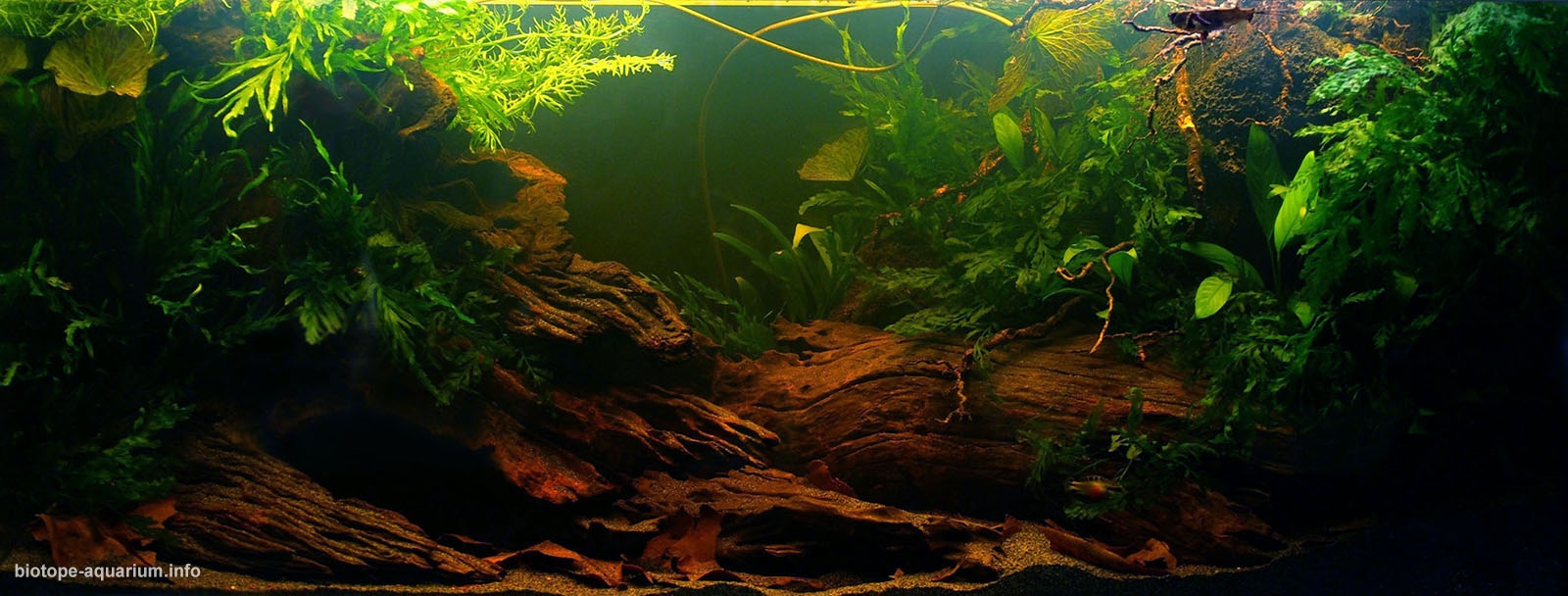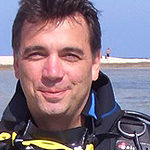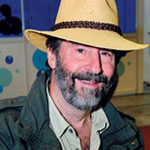Slow flowing forest duct of the Nun River basin, in the north of Bayelsa State, Nigeria
The 2nd place in the final of the Biotope Aquarium Design Contest 2014
![]() Russia. Svetlana Kirillova
Russia. Svetlana Kirillova

Volume: 180 L
List of fishes: Gnathonemus petersii, Hymenochirus boettgeri, Pantodon buchholzi, Pelvicachromis pulcher, Chromaphyosemion bitaeniatum
List of plants: Anubias barteri angustifolia afzelii, Bolbitis heudelotii, Ceratopteris thalictroides, Crinum calamistratum
Biotope description: Nun River is the longest (160 km) continuation of the Niger River. The Nun River begins near the village of Aboh, where the Niger River splits in two, forming Nun and Forcados, flows through the rain forests, swamps and mangroves, and empties into the Gulf of Guinea. Flooding from monsoon rains lasts from June to September, then the water level drops, and in February, with the arrival of the flood waters from the Niger River, rises again. Forest rivers and streams of the Nun River basin are home to many species of fish and other aquatic organisms. Although oil production causes serious damage to the local nature, yet in clean rivers significant biodiversity can be found. Mainly semi-aquatic plants grow in places where sun can reach the earth surface through the trees.
Svetlana’s comment about the contest: Biotope Aquarium Design Contest is my favorite. Preparing for this competition and participating in it is like assemblying a jigsaw puzzle: first, information about the chosen waterbody should be gathered bit by bit, and here everything is important: geographical location, climate, soil, water parameters, marginal and aquatic plants, species of fish and other animals living in the waterbody. Then, soils and decorations close to natural should be found, species of fish and plants chosen and of all this the final version of the puzzle should be assembled: a biotope aquarium, that should be not only “accurate” and beautiful, but also viable, decorated to meet the needs of all its inhabitants. It is an incredibly exciting and challenging task, and when observing the natural behavior of fishes in an aquarium, I understand that all the efforts were not for nothing. The contest was organized at a very high level, I would like to thank the organizers and sponsors for the opportunity to take part in this wonderful event. It was a pleasure to meet with the participants, enthusiasts and professionals in aquaristic. And a special thank for the generous gift to the House of Creativity of Youth, the children are just happy with these beautiful aquaria!

It was fascinating to watch Svetlana in the beginning of the contest. She tried several kinds of decoration material and in the very end, she started to set it up as it was in the end. The result is fantastic and I assume that many rivers in central and western Africa look like this. I haven’t been to central african rivers yet, but checked many pictures and her Biotope Aquarium just looks great! Perfect job!

1st place must be Biotope by Svetlana, because it had 100% description, and an habitat of correct plants and fish species living together (G. petersii could be more). The décor was not only correct, but very well done to perfection selected materials.

The richness of the dark, beautifully laid out bogwood, complementary sand and leaf litter, coupled with the rich red of the killifish and the ancient looking bolbitis just screams west africa and old world, dark forest and I think this biotope works incredibly well. I think the water lilies will clash with the ferns as they grow in terms of looks and habitat representation but also in terms of water flow and light requirements. But apart from that, a great looking biotope.

Svetlana Kirillovas african biotope tank is a perfect example for a well positioned decor. To create a natural looking biotope aquarium with a quite small tank for quite many species is a difficult job. But it worked very well. The big pieces of wood in combination with some plants create a great perspective and enough hiding places for the fish. For me it’s the most interesting tank. One can’t see all the fishes at one time because of many hiding places on the other hand we have a great combination of fishes that all show different behavior. It would be a joy to own such biotope aquarium.
Great job, magnificent, excellent impression of naturalness. I felt like I was swimming through the trunks of the river basin Nun. Despite the bolbitis still are not so naturally placed and very densely packed, I believe the magic and the natural power of vegetation in this region is very well represented. Excellent assembly. Real good.

The aquarium was set up perfectly, but the presence of dwarf frogs in this particular zone is confusing. The soil placed in the aquarium is firm, but the frogs look for their food digging in the ground. All the rest of setup is great.

A very good arrangement of wood and plants. Also an interesting selection of fish in a ratio close to optimal. A very nice biotop, well done, which can develop over time and can be maintained easily. Congratulations for this beautiful biotop!

When I look at this biotope aquarium I feel like I am taken to a mysterious jungle stream in Africa. I have to congratulate Svetlana Kirillova, large pieces of wood are extremely hard to place in an aquarium and make them look good and here they look just perfect!

Once again, Svetlana has outdone herself with a biotope true to its origins. The sloping shoreline effect works well, especially having the roots and ferns tumbling over the bank into the water. In a small space, she has managed to create a complex of microhabitats well-suited for the fish included, and reflecting their natural adaptations – quiet shoreline areas for the Pantodon and killies, spacious overhangs and caves for the Gnathonemus, and sandy substrate with plenty of caves and cover for the P. pulcher. The overall impression is one of luxuriant tropical growth, shaded by overhanging tree branches. There is an excellent sense of depth created by layering and terracing of wood with the substrate. All fish are behaving as they would in nature occupying their optimum zones.
